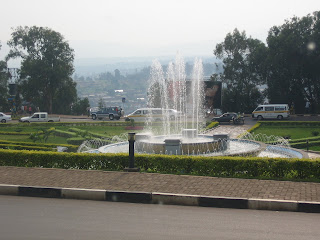The Gentrification of Kigali

And when that happens, the inevitable happens. Land that was once undesirable has now become invaluable. The simple brick homes of Lower Kiyovu, just below the city center where the big rotunda is located, are being demolished in favor of larger homes and office buildings. The landowners have been compensated enough to move somewhere else (probably nowhere near the city center, given the property prices these days), and massive bulldozers are tearing everything down.
The big rotunda in Kiyovu
It's sad, I guess, to see the ruins and think about all the people that now have to move to the outskirts of town. But, of course, it means that the country is moving forward. Businesses want that land, and that means investment. I just hope the prior owners are being adequately compensated.




11 Comments:
It would be interesting to find out whether the compensation is really sufficient. The people that I have talked to who have been moved seem far from happy about it. Do you have any information on that?
It would be doubly interesting to know how the many people relocated for the construction of the monolithic new US Embassy building feel about their compensation.
Thanks for your commentary on this, Morgan. I was in Kigali in September 2007 and again in February 2008 and noticed that Kigali changed a lot in that short time. Large new buildings that hadn't been there in September were fully built in February. While it is sad for the people who lose their homes (and may not be adequately compensated), I find the bustle and excitement of Kigali encouraging. When I read New Times articles about continued genocide ideology (especially in schools), I worry about Rwanda. When I see the construction and experience the positive energy of Kigali, I can believe in "Never Again."
Maurice, I heard that there are three categories of compensation, though I'm not sure what kinds of amounts they're giving...
They are giving the most money to those who had fired-brick houses, a bit less to those who had some sort of blended structure, and almost nothing to those who had mud homes.
As for the US Embassy, I can't remember what the hill looked like when there were homes--I remember in 2006 being struck by the vastness of the dirt plot.
Okay, correction:
BBC reported yesterday that no one is receiving compensation.
Hm.
This is oh-so-emblematic of the way information gets around in Kigali, but I have heard another version...
Umudugudu (subsidized, gov't built housing) was set up on the road to Nyamata, which is the road to the new airport that is going to be constructed. People were offered a house there or money. Many people chose money because the houses were so far away from the center of town. I then heard that many people, having a sudden influx of cash, managed it poorly...and now are without homes and have little money left.
If anyone has heard otherwise, please post!
Morgan,
We were in Kigali in March, and we visited a several imidugudu, as well as the Kigali Planning Department. There are different financing models of imidugudu that we saw, which would be too long to go into here. But the one that just been partially opened is in Batsinda, which you probably heard about. The part that opened was for the "low income" people, but a house still costs US$6,000 and all infrastructure as well as wall and ceiling finishes were up to the residents to complete, making it even more expensive. Some of the residents are going to be moved from the village of Umubwe, which is torn down. The people who used to own land there could sell it to the government and buy the houses in Batsinda. For the landless, the Kigali officials didn't know where they went.
I think regardless of the compensation package, this is a tragedy for the city. To move poor people out of the city centre is a loss for the social diversity of the city and will lead to a segregation of the city along income groups.
A much better strategy would have been for the city to have improved the property rights laws and infrastructure in poor Kiyovu to promote its development.
And here is my post on the issue, using information from a new New Times article:
http://mostlymaurice.blogspot.com/2008/08/poor-kiyovu.html
Thanks, Maurice! Awesome as always.
Morgan, thanks for raising this, but I'm not entirely sure that all the construction is demand-driven. There is also a supply-side: money from various sources being invested in new housing. I'm not convinced that local demand exists to fill all these new houses and offices. Of course, the aid industry is to blame for some of the inflated economy.
Aside from the (vital) question of compensation, the urban: rural divide is of great importance. While Kigali rises, most of the rural areas stagnate. Inequality in Rwanda is worse now than its ever been.
Yutaka, I would love to hear more about your visit to Rwanda. cdhuggins@gmail.com
It's exciting to see Rwanda developing so rapidly.
Post a Comment
<< Home